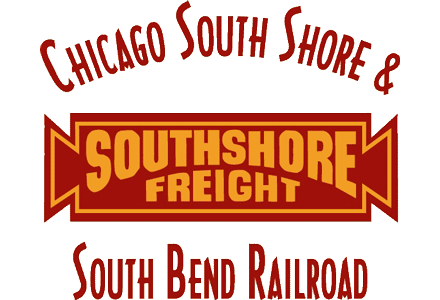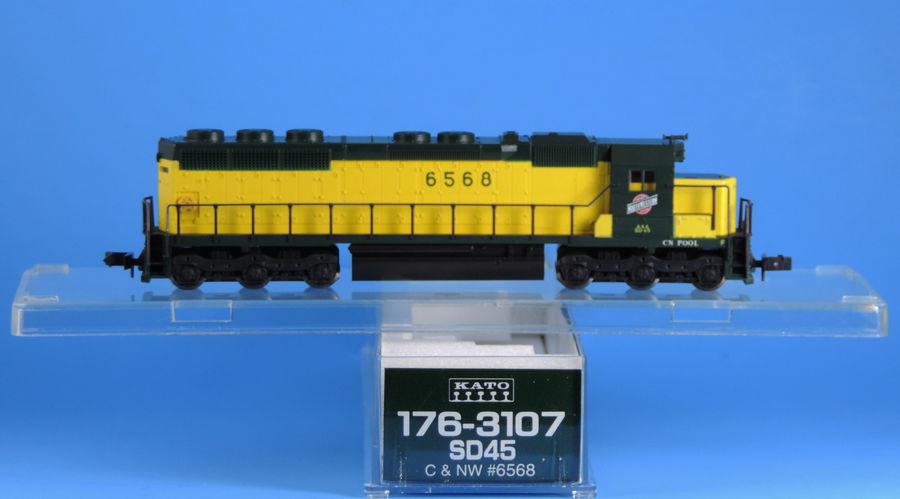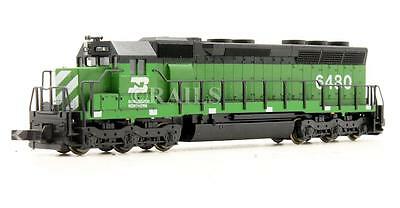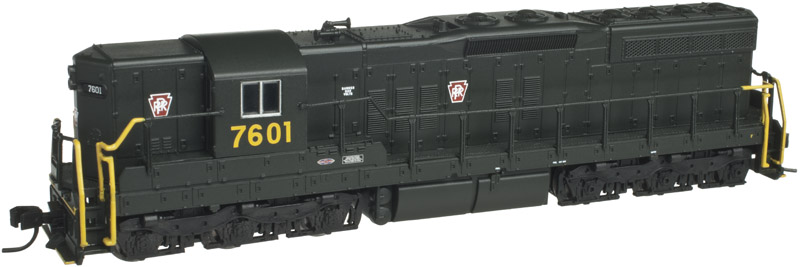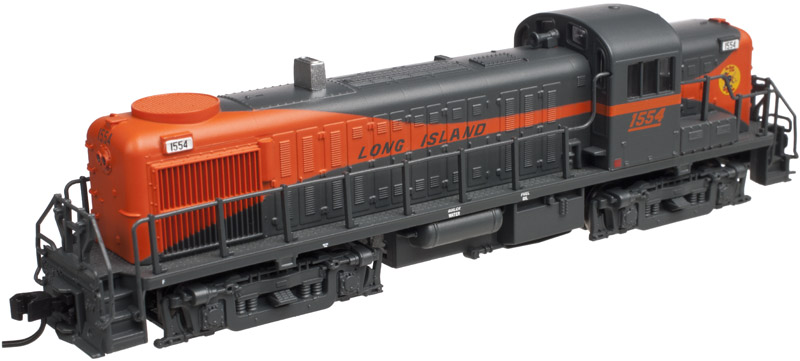Specific Item Information: GOLD MODEL
FUNCTIONALITY FEATURES (GOLD MODELS ONLY):
• Over 20 sound effects are available, including engine start-up and shutdown, prime mover sounds through all eight notches, bell, air horn, air compressor,
dynamic brakes and more.
• There are up to 16 user-selectable horns, 2 user-selectable bells, and 2 user-selectable synchronized brake squeals.
• Manual and Automatic Notching modes with the ability to change modes "on the fly" are provided for true realism.
• Supports all DCC-programming modes
• DCC includes RailCom and RailComPlus, with 14, 28 or 128 speed steps and with 2-digit and 4-digit addressing.
• Flexible mapping of function keys F0 to F28.
• A total of 6 DCC function outputs are available, and all can be function mapped (disable, brightness, light effects) individually
Model Information: The same mechanism is used for the GP38, GP38-2, GP40 and GP40-2. Production of the GP38-2 was started in China in 1996. It was later revised with a DCC-Ready chassis in 2003.
Both of the Chinese mechanisms run fine but the first releases (1996) do not support drop in decoders. Both versions use a dual-flywheel, split frame chassis with a 5-Pole skew-wound motor.
The current model features: Golden-white LEDs; Separately-applied roof detail; Painted safety rails; Directional lighting; Blackened metal wheels; Scale Speed motor; Separately-applied coupler cut levers; Non-Dynamic, Dynamic, and Extended Range Dynamic Brakes used where appropriate; Pilot: Standard or with Snow Plow; Low short hood and High short hood versions available.
Both of the Chinese mechanisms run fine but the first releases (1996) do not support drop in decoders. Both versions use a dual-flywheel, split frame chassis with a 5-Pole skew-wound motor.
The current model features: Golden-white LEDs; Separately-applied roof detail; Painted safety rails; Directional lighting; Blackened metal wheels; Scale Speed motor; Separately-applied coupler cut levers; Non-Dynamic, Dynamic, and Extended Range Dynamic Brakes used where appropriate; Pilot: Standard or with Snow Plow; Low short hood and High short hood versions available.
DCC Information: Early Chinese versions are DCC-friendly requiring a complicated split-board DCC install.
Later versions are DCC-Ready accepting the following plug-in decoders (non-sound):
- Digitrax DN163A0: 1 Amp N Scale Mobile Decoder for Atlas N-Scale GP40-2, U25B, SD35, Trainmaster, B23-7 and others,
- TCS AMD4 : 4 function BEMF decoder for Atlas N Scale engines,
- NCE N12A0: Plug and play decoder for N-Scale Atlas GP40-2, U25B, U23B, B23-7, 30-7, 36-7, GP38, SD25, TRAINMASTER, etc.
Unfortunately, the only way to tell which kind you have is to remove the shell and check the chassis. If it has two small lightboards, you have an old one in your hand. A single long lightboard indicates a DCC-Ready chassis.
Later versions are DCC-Ready accepting the following plug-in decoders (non-sound):
- Digitrax DN163A0: 1 Amp N Scale Mobile Decoder for Atlas N-Scale GP40-2, U25B, SD35, Trainmaster, B23-7 and others,
- TCS AMD4 : 4 function BEMF decoder for Atlas N Scale engines,
- NCE N12A0: Plug and play decoder for N-Scale Atlas GP40-2, U25B, U23B, B23-7, 30-7, 36-7, GP38, SD25, TRAINMASTER, etc.
Unfortunately, the only way to tell which kind you have is to remove the shell and check the chassis. If it has two small lightboards, you have an old one in your hand. A single long lightboard indicates a DCC-Ready chassis.
Prototype History: The EMD GP38-2 is a four-axle diesel-electric locomotive of the road switcher type built by General Motors, Electro-Motive Division. Part of the EMD Dash 2 line, the GP38-2 was an upgraded version of the earlier GP38. Power is provided by an EMD 645E 16-cylinder engine, which generates 2000 horsepower (1.5 MW). Most built still remain in service in the modern era due to ease of maintenance and exceptional reliability.
The GP38-2 differs externally from the earlier GP38 only in minor details. Its most distinctive identifying feature is the cooling water level sight glass on the right side of the long hood. The battery box covers of the Dash 2s are bolted down instead of hinged. It can be distinguished from the contemporary GP39-2 and GP40-2 in that its Roots blown engine had two exhaust stacks, one on each side of the dynamic brake fan, if equipped, while the turbocharged GP39-2 and GP40-2 has a single stack. The GP39-2 has two radiator fans on the rear of the long hood like the GP38-2, while the GP40-2 has three. It was also available with either a high-short-hood, common on Norfolk Southern units, or a low-short-hood, which is found on most other railroads.
From Wikipedia
The GP38-2 differs externally from the earlier GP38 only in minor details. Its most distinctive identifying feature is the cooling water level sight glass on the right side of the long hood. The battery box covers of the Dash 2s are bolted down instead of hinged. It can be distinguished from the contemporary GP39-2 and GP40-2 in that its Roots blown engine had two exhaust stacks, one on each side of the dynamic brake fan, if equipped, while the turbocharged GP39-2 and GP40-2 has a single stack. The GP39-2 has two radiator fans on the rear of the long hood like the GP38-2, while the GP40-2 has three. It was also available with either a high-short-hood, common on Norfolk Southern units, or a low-short-hood, which is found on most other railroads.
From Wikipedia
Road Name History: The CSS&SB was born in 1925 when traction and utility magnate Samuel Insull acquired and reorganized the Chicago Lake Shore & South Bend. The CLS&S was a robustly built electric interurban line connecting South Bend, Indiana with Michigan City, Gary, East Chicago, Hammond and finally Illinois Central’s suburban line at Kensington, Illinois, just south of Chicago. The line was already blessed with broad curves and slight grades so it was not difficult for Insull to convert the line into a heavy electric in a style that would be familiar to fans of PRR, DL&W or Reading. Insull also secured trackage rights on the IC into Chicago. The overhead wire is a mix of catenary and trolley wire (the latter used on some of the low speed street trackage.)
Like many railroads, CSS&SB fell into bankruptcy in 1932 and Samuel Insull lost control. The Golden Age of Traction was over and the new management began to place more emphasis on freight service.
In addition to some boxcab electrics, the South Shore was one of two American roads to own “Little Joe” electrics. These had been built in the 1950s for the Soviet Union but Cold War tensions killed the deal. They were re-gauged (Russia is 5’ gauge) and sold to South Shore and Milwaukee Road instead. The “Little Joe” name was a reference to Joseph Stalin.
In 1967, Chesapeake & Ohio gained control of the South Shore and the occasional C&O diesel could be found switching the South Shore. In 1981, the Little Joe’s were retired and freight operations were dieselized with yellow and blue (like Chessie without the vermilion) GP38-2’s. Passenger operations remained electrified. Passenger losses were subsidized by the state of Indiana through this period. In 1982, the Northern Indiana Commuter Transportation District paid for a fleet of new passenger cars that replaced the heavy steel cars that first went into service in the Insull era.
In 1989, the South Shore fell into bankruptcy, bringing an end to CSX (formerly C&O) control of the line. Northern Indiana Commuter Transportation District took over operation of the money losing passenger operations. The following year, the Anacostia & Pacific short line group established a new Chicago South Shore & South Bend Railroad to provide freight service on the line. It was this group that brought back the orange and maroon paint scheme last used on the Little Joes. They currently operate 182 miles of line, much of it on trackage rights.
Traffic on the South Shore is primarily a pair of power stations that receive unit coal trains and mills that ship pig iron and finished steel. They also carry grain, manufactured goods, paper, and roofing materials.
Major customers include: Alexander Chemical, ArcelorMittal-Burns Harbor, Criterion Catylst & Technologies, GAF Corporation, Five Star Sheets, Foodliner, Maryland Pig Services, Northern Indiana Public Service, NAMASCO/Primary Steel, PSC Metals, Reserve Marine/Transfer Logistics, Rollcoater, Sims Metal Management, U.S. Steel - Midwest, USALCO, and Windy City Warehouse.
Like many railroads, CSS&SB fell into bankruptcy in 1932 and Samuel Insull lost control. The Golden Age of Traction was over and the new management began to place more emphasis on freight service.
In addition to some boxcab electrics, the South Shore was one of two American roads to own “Little Joe” electrics. These had been built in the 1950s for the Soviet Union but Cold War tensions killed the deal. They were re-gauged (Russia is 5’ gauge) and sold to South Shore and Milwaukee Road instead. The “Little Joe” name was a reference to Joseph Stalin.
In 1967, Chesapeake & Ohio gained control of the South Shore and the occasional C&O diesel could be found switching the South Shore. In 1981, the Little Joe’s were retired and freight operations were dieselized with yellow and blue (like Chessie without the vermilion) GP38-2’s. Passenger operations remained electrified. Passenger losses were subsidized by the state of Indiana through this period. In 1982, the Northern Indiana Commuter Transportation District paid for a fleet of new passenger cars that replaced the heavy steel cars that first went into service in the Insull era.
In 1989, the South Shore fell into bankruptcy, bringing an end to CSX (formerly C&O) control of the line. Northern Indiana Commuter Transportation District took over operation of the money losing passenger operations. The following year, the Anacostia & Pacific short line group established a new Chicago South Shore & South Bend Railroad to provide freight service on the line. It was this group that brought back the orange and maroon paint scheme last used on the Little Joes. They currently operate 182 miles of line, much of it on trackage rights.
Traffic on the South Shore is primarily a pair of power stations that receive unit coal trains and mills that ship pig iron and finished steel. They also carry grain, manufactured goods, paper, and roofing materials.
Major customers include: Alexander Chemical, ArcelorMittal-Burns Harbor, Criterion Catylst & Technologies, GAF Corporation, Five Star Sheets, Foodliner, Maryland Pig Services, Northern Indiana Public Service, NAMASCO/Primary Steel, PSC Metals, Reserve Marine/Transfer Logistics, Rollcoater, Sims Metal Management, U.S. Steel - Midwest, USALCO, and Windy City Warehouse.
Brand/Importer Information: In 1924 Stephan Schaffan, Sr. founded the Atlas Tool Company in Newark, New Jersey. In 1933 his son, Stephan Schaffan, Jr., came to work for his father at the age of sixteen. Steve Jr. built model airplanes as a hobby and frequented a local hobby shop. Being an enterprising young man, he would often ask the owner if there was anything he could do to earn some extra spending money. Tired of listening to his requests, the hobby-store owner threw some model railroad track parts his way and said, "Here, see if you can improve on this".
In those days, railroad modelers had to assemble and build everything from scratch. Steve Jr. created a "switch kit" which sold so well, that the entire family worked on them in the basement at night, while doing business as usual in the machine shop during the day.
Subsequently, Steve Jr. engineered the stapling of rail to fiber track, along with inventing the first practical rail joiner and pre-assembled turnouts and flexible track. All of these products, and more, helped to popularize model railroading and assisted in the creation of a mass-market hobby. The budding entrepreneur quickly outgrew the limitations of a basement and small garage operation. Realizing they could actually make a living selling track and related products, Steve and his father had the first factory built in Hillside, New Jersey at 413 Florence Avenue in 1947. On September 30, 1949, the Atlas Tool Company was officially incorporated as a New Jersey company.
In 1985, Steve was honored posthumously for his inventions by the Model Railroad Industry Association and was inducted into the Model Railroad Industry Hall of Fame in Baltimore, Maryland. In addition, Steve was nominated and entered into the National Model Railroad Association Pioneers of Model Railroading in 1995.
In the early 1990s, the Atlas Tool Company changed its name to Atlas Model Railroad Company, Inc.
In those days, railroad modelers had to assemble and build everything from scratch. Steve Jr. created a "switch kit" which sold so well, that the entire family worked on them in the basement at night, while doing business as usual in the machine shop during the day.
Subsequently, Steve Jr. engineered the stapling of rail to fiber track, along with inventing the first practical rail joiner and pre-assembled turnouts and flexible track. All of these products, and more, helped to popularize model railroading and assisted in the creation of a mass-market hobby. The budding entrepreneur quickly outgrew the limitations of a basement and small garage operation. Realizing they could actually make a living selling track and related products, Steve and his father had the first factory built in Hillside, New Jersey at 413 Florence Avenue in 1947. On September 30, 1949, the Atlas Tool Company was officially incorporated as a New Jersey company.
In 1985, Steve was honored posthumously for his inventions by the Model Railroad Industry Association and was inducted into the Model Railroad Industry Hall of Fame in Baltimore, Maryland. In addition, Steve was nominated and entered into the National Model Railroad Association Pioneers of Model Railroading in 1995.
In the early 1990s, the Atlas Tool Company changed its name to Atlas Model Railroad Company, Inc.
Item created by: CNW400 on 2019-12-16 14:20:28. Last edited by CNW400 on 2020-08-31 11:42:54
If you see errors or missing data in this entry, please feel free to log in and edit it. Anyone with a Gmail account can log in instantly.
If you see errors or missing data in this entry, please feel free to log in and edit it. Anyone with a Gmail account can log in instantly.




